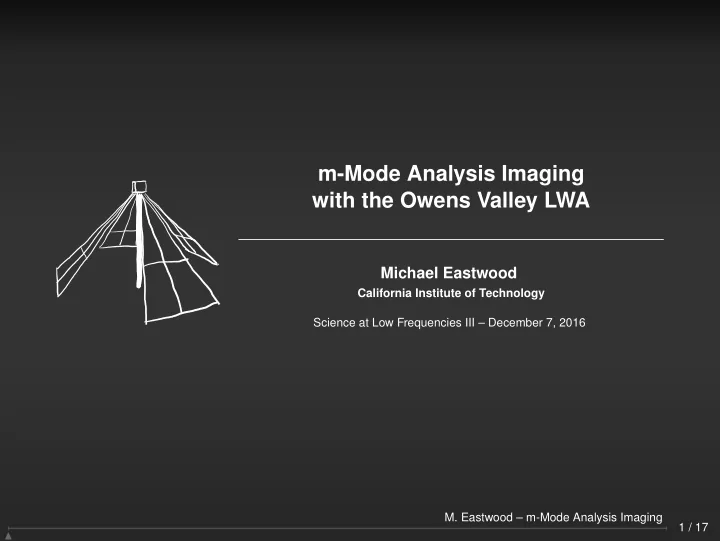

m-Mode Analysis Imaging with the Owens Valley LWA Michael Eastwood California Institute of Technology Science at Low Frequencies III – December 7, 2016 M. Eastwood – m-Mode Analysis Imaging 1 / 17 N
Caltech Harvard/SAO Gregg Hallinan Lincoln Greenhill Sandy Weinreb Ben Barsdell → NVIDIA Stephen Bourke → Chalmers Danny Price → Berkeley Jake Hartman → Google Hugh Garsden Harish Vedantham OVRO Jonathon Kocz Dave Woody Kate Clark James Lamb Marin Anderson OVRO staff Ryan Monroe JPL David Wang Larry D’Addario Joe Lazio and the rest of the LWA team M. Eastwood – m-Mode Analysis Imaging 2 / 17 N
Introduction Foregrounds in 21 cm Cosmology M. Eastwood – m-Mode Analysis Imaging 3 / 17 N
Introduction Foreground Leakage is a Problem z ⇠ 8 . 4 Ali et al. (2015) M. Eastwood – m-Mode Analysis Imaging 4 / 17 N
Our understanding of the VHF sky is an extrapolation of this map. Haslam et al. (1981, 1982) M. Eastwood – m-Mode Analysis Imaging 5 / 17 N
We need a measurement of the VHF sky. Eastwood et al. (in prep.) M. Eastwood – m-Mode Analysis Imaging 6 / 17 N
The Owens Valley LWA The OVRO LWA 100 Hour Dataset Observing Period 2016-03-19 through 2016-03-23 Total Observation Time 100 hours Integration Time 13 seconds Frequency Range 25 – 82 MHz Resolution 10 – 20 arcminutes M. Eastwood – m-Mode Analysis Imaging 7 / 17 N
The Owens Valley LWA The Data Reduction Pipeline M. Eastwood – m-Mode Analysis Imaging 8 / 17 N
The Owens Valley LWA Calibration • Gain calibration occurs once per day • Bright sources are peeled from the dataset (Cyg A, Cas A) • Near-field sources of RFI (arcing power lines) subtracted • Flux scale tied to Perley & Butler 2016 TTCal Freely available under an open source license (GPLv3+) https://github.com/mweastwood/TTCal.jl M. Eastwood – m-Mode Analysis Imaging 9 / 17 N
m-Mode Analysis in Theory The Challenge of Widefield Imaging Z visibility = (sky brightness) ⇥ (beam) ⇥ (fringe pattern) d Ω We want to solve this equation quickly and accurately . Transit telescopes can exploit a symmetry that greatly simplifies the necessary computation for all-sky synthesis imaging. M. Eastwood – m-Mode Analysis Imaging 10 / 17 N
m-Mode Analysis in Theory m-Mode Analysis Fundamentals Z visibility = (sky brightness) ⇥ (beam) ⇥ (fringe pattern) d Ω For a telescope that does not steer its beam, visibilities are a periodic function of the sidereal time. visibility sidereal time Fourier transform � � � � � � � � � � � � � � � � � � � � � � ! m-mode . . 0 1 0 ... 1 0 1 . . . . B C B C B C m-modes A = transfer matrix a lm B C B C B C . . @ @ ... A @ A . . . . Shaw et al. (2014, 2015) M. Eastwood – m-Mode Analysis Imaging 11 / 17 N
m-Mode Analysis in Theory The Fundamental Equation B v = B Ba + noise v is the vector of m-modes. This is what is measured by the interferometer. B is the transfer matrix. It describes the response of the B B interferometer to the sky. This matrix is block diagonal . a is the vector of spherical harmonic coefficients (for the sky brightness). Shaw et al. (2014, 2015) M. Eastwood – m-Mode Analysis Imaging 12 / 17 N
m-Mode Analysis in Theory Regularizing the Problem Goal: Estimate a given the observations v , but unmeasured modes should be (smoothly) set to zero. Least squares with Tikhonov regularization k v � Ba k 2 + λ k a k 2 I ) − 1 B � a = argmin ˆ = ( B B B ∗ B B + λ I B I B B ∗ v Problem: How do we choose λ ? (come talk to me!) M. Eastwood – m-Mode Analysis Imaging 13 / 17 N
m-Mode Analysis in Theory Summary of m-Mode Analysis Imaging • Block-diagonal matrix equation • Exact treatment of widefield effects • Automatic deconvolution of large scale structures • Coherent synthesis imaging of a full sidereal day M. Eastwood – m-Mode Analysis Imaging 14 / 17 N
m-Mode Analysis in Practice m-Mode Analysis at the OVRO LWA • Use spherical harmonics with l 1000 • Transfer matrix is 500 GB per frequency channel • Computations parallelized over 160 workers • 12 hours to compute elements of the transfer matrix • 10 minutes to solve the imaging equations BPJSpec Freely available under an open source license (GPLv3+) https://github.com/mweastwood/BPJSpec.jl M. Eastwood – m-Mode Analysis Imaging 15 / 17 N
m-Mode Analysis in Practice Preliminary Map Eastwood et al. (in prep.) M. Eastwood – m-Mode Analysis Imaging 16 / 17 N
m-Mode Analysis in Practice Summary • Need a low frequency anchor to foreground maps for 21 cm cosmology • (Preliminary) all-sky maps with ⇠ 10 arcminute resolution • Source removal remains the largest challenge • Data release coming “soon” M. Eastwood – m-Mode Analysis Imaging 17 / 17 N
Backup Slides M. Eastwood – m-Mode Analysis Imaging 18 / 23 N
M. Eastwood – m-Mode Analysis Imaging 19 / 23 N
M. Eastwood – m-Mode Analysis Imaging 20 / 23 N
Backup Slides System Parameters • 288 crossed-dipole antennas (expanding to 352) • 1.5 km maximum baseline (expanding to 2.5 km) • 512-input LEDA correlator • 24.7 MHz to 82.3 MHz instantaneous • 5 antennas have noise-switched front ends M. Eastwood – m-Mode Analysis Imaging 21 / 23 N
Backup Slides Temperature History M. Eastwood – m-Mode Analysis Imaging 22 / 23 N
Backup Slides Temperature History M. Eastwood – m-Mode Analysis Imaging 22 / 23 N
Backup Slides Temperature History M. Eastwood – m-Mode Analysis Imaging 22 / 23 N
Backup Slides The 21 cm Signal M. Eastwood – m-Mode Analysis Imaging 23 / 23 N
Recommend
More recommend